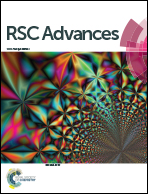Synthesis and characterization of novel sulfanilic acid–polyvinyl chloride–polysulfone blend membranes for metal ion rejection†
Abstract
Near-complete removal of heavy metals, namely Cd(II), Cr(VI) and Pb(II), has been attempted by a membrane purification process using a blend of modified polyvinyl chloride (PVC) and polysulfone (PSf), prepared by the diffusion induced phase separation (DIPS) method. The prepared novel material was characterized by NMR, ATR-IR spectroscopy and DSC. The sulphonyl groups incorporated into PVC enhance the hydrophilicity and are substantiated by water uptake, contact angle (CA) and flux studies. The obtained properties of the blend membrane like increased surface roughness and porosity are observed from AFM and SEM analysis. An enhanced rejection of ∼95% which is about 1.15, 1.41 and 1.37 times better than the commercially available NF 270 membrane was observed, for Cd(II), Cr(VI) and Pb(II) respectively. The work was further extended to study the antifouling property and the interference of other existing metal ions on the performance. An improved antifouling property with 98.5% rejection for bovine serum albumin (BSA) and a 75.6% flux recovery ratio (FRR) was achieved. The study gains significance in exploring the incorporation of sulphonyl groups in to polymers, to enhance membrane performance.


 Please wait while we load your content...
Please wait while we load your content...